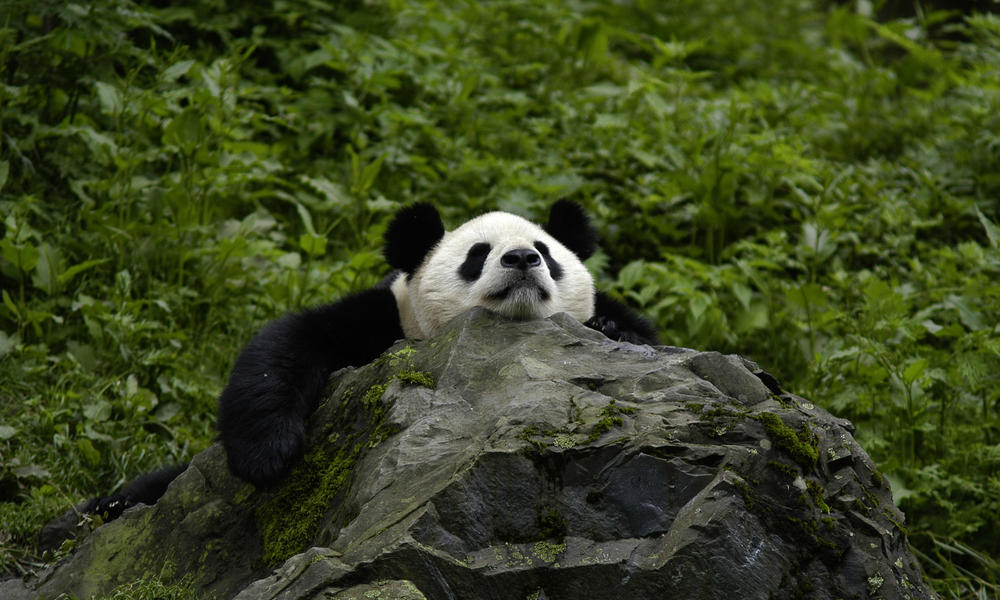Pandas:
- Are the rarest member of the bear family
- WWF logo since its creation in 1961
- Generally Live in mountainous areas of Western China
- By eating so much bamboo and spreading the bamboo seeds they are an important part of conserving the forests that home various other animal species
Endangered Because:
- Habitat is being cut down for social development in China
- Low reproduction rate makes it difficult to up their numbers from previous drops
What WWF is Doing:
- Influences Chinese Governments decision making on issues such as conservation
- Increasing protected area of forest for pandas to live in
- Creating wildlife corridors to prevent pandas from becoming isolated in an attempt to encourage reproduction
- Patrolling against poaching
- Assisting the wildlife reserves by building close by necessities
- Continued research and monitoring of panda behaviour.
Practicalities
When you consider how much extra effort is put into Panda conservation by WWF than to the more endangered species listed in the last post such as the Leatherback Turtle and Sumatran Tiger, and the lack of major progress that has been made by the conservation efforts in terms of increasing numbers in the wild, it makes you wonder if it's worth doing.
In an online article for the Guardian in 2009 discussing this issue, wildlife presenter said the following things:
"The truth is, pandas are extraordinarily expensive to keep going. We spend millions and millions of pounds on pretty much this one species, and a few others, when we know that the best thing we could do would be to look after the world's biodiversity hotspots with greater care. Without habitat, you've got nothing. So maybe if we took all the cash we spend on pandas and just bought rainforest with it, we might be doing a better job."
"But we have to accept that some species are stronger than others. The panda is a species of bear that has gone herbivorous and eats a type of food that isn't all that nutritious, and that dies out sporadically. It is susceptible to various diseases, and, up until recently, it has been almost impossible to breed in captivity. They've also got a very restricted range, which is ever decreasing, due to encroachment on their habitat by the Chinese population. Perhaps the panda was already destined to run out of time."
Despite these very valid and logical arguments, the fact is that people in the Western World are the ones whose donations make WWF run, and if the Panda went extinct people would question the overall success of WWF for its inability to secure the future of its flagship species. The work that WWF does with the Chinese government is also important in a political sense as well, as it aids communication between China and the Western World.
The Giant Pandas Relationship With Western Society
The first westerner to know of the Giant Pandas existence was French missionary Armand David (left), who saw a panda pelt (skin with fur) in a hunters house and bought it at "a very high price", describing it in his diary as "a beautiful pelt from a black and white bear". The fur was put on display in the French National Museum in Paris, where it was given the name of Giant Panda.
From this, even the earliest connotations that the western wold associated with the Panda were things such as beauty and cuteness, summed up by the fact that the first live Giant Panda in the Western World was brought over to America in 1936 and registered as a puppy.
As the wests interest in pandas grew, they were given out as political gifts to other countries by China between 1957 and 1983 (see diagram above) as they didn't realise the rarity of them. Pandas are now only allowed to leave China on a loan basis for research and breeding programs. The WWF logo was based off Chi-Chi, a panda given to the United Kingdom and ended up in London Zoo.
"WWF’s founders were aware of the need for a strong, recognizable symbol that would overcome all language barriers. They agreed that the big, furry animal with her appealing, black-patched eyes would make an excellent choice." (WWF Website)
The recognition and attention that the Giant Panda gets globally because of it's use on the WWF logo means that a lot more attention is payed to them than is representative, even within WWF, an example of this is described in the video below, where composer Yanni talks about his experiences with and the importance of pandas.
Conclusion
It is clear that conservation of Giant Pandas is an expensive process and is an uphill battle, especially given how uneconomical it is. It is god therefore that peoples relationship with the Giant Panda tends to be more of an emotional thing rather than a logical and thoughtful one, as this keeps people interested in the continued existence of pandas. The fact that it's a symbolic species for conservation in general means that it must me kept alive in order to maintain faith in conservation itself.

No comments:
Post a Comment